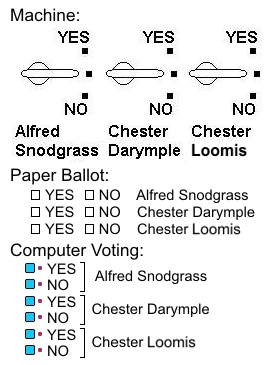
Plurality vote blender
- The defective Plurality Voting System (vote for only one) is being used.
- The third party candidate has to steal votes from the two mainstream party candidates.
- The third party candidate will steal more votes from the other candidate most like him.
- The mainstream candidate most unlike the third party candidate will probably win.
- The third party candidate entering the race will probably cause the mainstream candidate most unlike him to win.
- The third party candidate leaving the race will remove the bias against the mainstream candidate most like him.
- The third party candidate would have to outpoll both mainstream parties to win.
- The Plurality Voting System puts heavy biases on all candidates when more than two candidates run.
How can we remove this bias?
- There is only one way:
- Voting for one candidate must not decrease any opponent's votes.
How can this be achieved?
- Two things must be done:
- The Plurality Voting System (vote for only one) used in most places must be permanently abolished.
- The Independent Voting System (vote on each choice separately) must be adopted into law.
